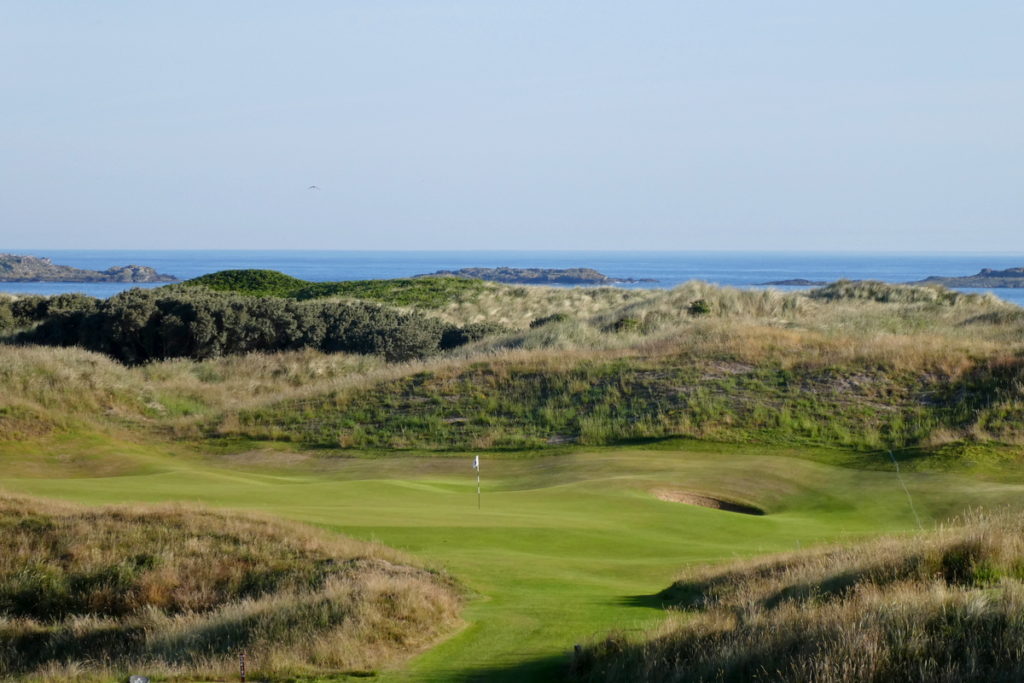Is accuracy being sufficiently tested in professional golf given the prodigious distances the longest hitters are achieving?
MCINTOSH: It’s not really a good example to keep on narrowing fairways to try and test the professionals. I’d prefer to see bolder design decisions around greens that accentuate the need for correct placement; severe hazards, slopes and shaping along with firm conditioning that counters against the prodigious spin these players can achieve.
LYNCH: I don’t think it is, technology has made it easier to hit the ball long and straight, +300 yards drives are a normal occurrence, a lot of course’s find it hard to defend this. We need more strategic design and contouring of fairways. A popular example would be the 10th at Augusta, most right handed pros hit 3 would, because they need that right to left shape on the ball to get to the optimum position which ties in with good green design.

EBERT: I believe accuracy will be tested well at Portrush. There are many holes where a driver may not be the best option from the tee, however tempting, so accurate placement of tee shots and approach shots will be essential as the rough is reported to be fierce.
MACKENZIE: Members and visitors also have to enjoy playing these courses, so there has to be a balance between toughening them up for the very best and keeping them enjoyable for all of the rest. The best players seem to be winning regardless. There is a lot more to Brooks Koepka than raw power, for instance.
Interestingly, now with the return of The Open to Northern Ireland that means only Wales from the United Kingdom has never hosted the event. Do you see it happening in the years ahead and is Royal Porthcawl the only likely candidate?
MACKENZIE: 10 years ago, would you have anticipated The Open returning to Portrush?
EBERT: There are a lot of issues to be considered in taking an Open to a new venue. However, I am sure that the Welsh golfers and the Welsh Government would strongly support any possibility of The Open coming to Wales. Of the existing Welsh courses, it would seem that Royal Porthcawl is the only possible option.

LYNCH: It would be nice to spread it around alright, Wales is a lovely country. Royal Porthcrawl would probably be the popular choice, Aberdovey would be cool but the par would have to drop to 70 and it still might not be long enough.
MCINTOSH: I think Porthcawl is the obvious choice but there must be a few question marks around infrastructure, access and course suitability. I’ve certainly heard whispers but am not close enough to know if they are based in reality or just a wanton desire from those that sing its praises.
How difficult is it to create a venue that can sufficiently test the world’s best players so that fairness is achieved while the appropriate penalties for poor play are dished out accordingly?
MCINTOSH: Fairness is overrated: Living with the odd unlucky bounce is part of golf and I can’t think of many courses that cross the line too often. Especially on links courses, suitable penalties are easy to build in with bunkering, mounding and plenty of short grass that can move a slightly missed shot far away from the intended target.
EBERT: No real problem if the land is good, the layout is sound and the detail of the design is inspired. Royal Portrush has all of those.
MACKENZIE: A balance has to be struck on links courses because if you set it up to be too tough in still conditions then it is impossible in a gale. That is why scores are so low when conditions are fair on any links. If it is still and soft every links has had its underbelly exposed .
LYNCH: The Holy Grail!. It is a tough balance to create but a links layout is your best chance. I think the Open Championship at Turnberry in 2009 was a good example, the fact Tom Watson in his twilight years almost beat the best in the world.
Do you ever envision a day when The Open is contested on other links courses situated elsewhere in the world outside of the UK?
MACKENZIE: I doubt it.
LYNCH: I think you would have a better chance of the US Open moving to North Korea!
MCINTOSH: If it were to happen, then Portmarnock is the obvious choice. It has long been the most “Open-like” venue among the great courses not yet used and it guarantees a wonderful all-round tournament, not least because the Irish come out in droves to watch good golf.
EBERT: You should never say never!

Your pick to take home the Claret Jug is who and why?
EBERT: I have two dreams. One is for Rory to pip Tiger down the closing holes. The other is that Graeme McDowell lifts the Claret Jug. There would be no better story in golf!
MACKENZIE: Rickie Fowler because he has the same sort of short game magic that the likes of Seve had. He came close when Darren Clark won at St George’s. His time is coming.
MCINTOSH: Jon Rahm. He loves Ireland, just won at Lahinch and previously won at Portstewart when he eat at Portrush’s Harbour Bistro every night. He’s halfway there already.
LYNCH: I think Jon Rahm, has a good track record on links, winning the Irish Open at Lahinch and Portstewart, he is currently the inform horse and may slip in under the radar.

***
The Participants
Martin Ebert
The Director of Mackenzie & Ebert, Martin Ebert has advised seven of the ten Open championship venues. This includes the design work for the changes to the Ailsa Course at Turnberry before the 2009 Open and the more recent redesign to the course and the changes, including two new holes, at Royal Portrush. Currently working on existing course projects in many parts of the world including the UK, Ireland, Canada, Spain, Japan, Peru, Chile, Argentina and Japan.

Ally McIntosh
A Scotsman who grew up on the links. After relocating to Ireland and graduating through the EIGCA education program, he set up his own golf course design firm in 2010 and has since been fortunate enough to design and work on well-known seaside courses in both his home and adopted countries. He plays most of his golf at Portmarnock in Dublin.

Tom Mackenzie
Tom Mackenzie has been a golf course architect for 30 years now and is a partner of Mackenzie & Ebert although not directly involved with the Portrush project. He has been a member of Royal Dornoch since he was 16 years old — more than 30 years — and understands links golf in all conditions. He has worked on many of the top links throughout Great Britain & Ireland.

Jeff Lynch
Jeff Lynch, Director (re)GOLF, has been involved in golf course design & construction since his early years, Practicing as a professional architect for the past 18 with his fellow architects @regolfdesign, Lynch is committed to the game, the culture, and the environment.

